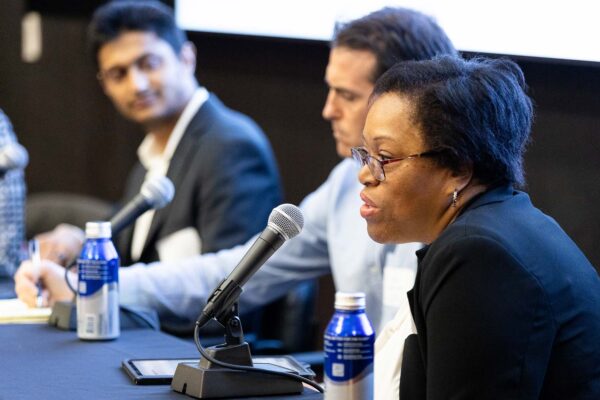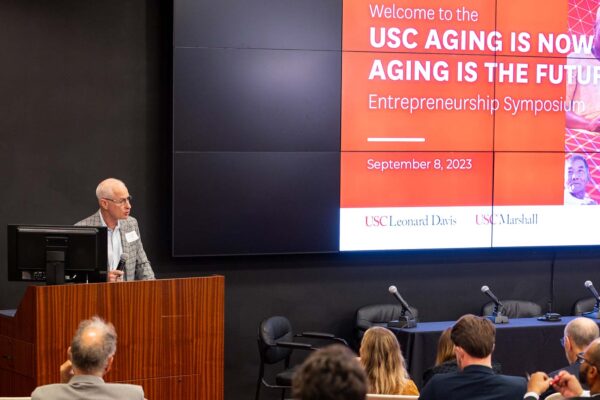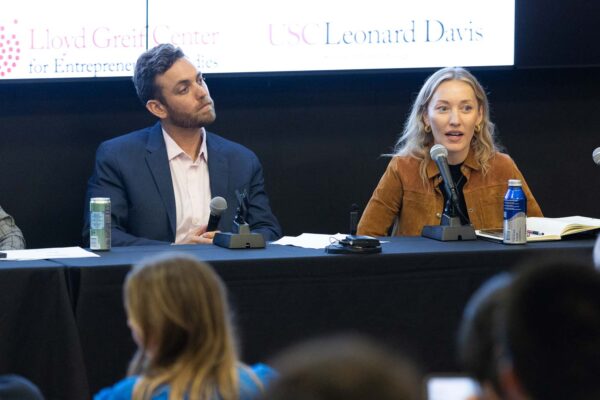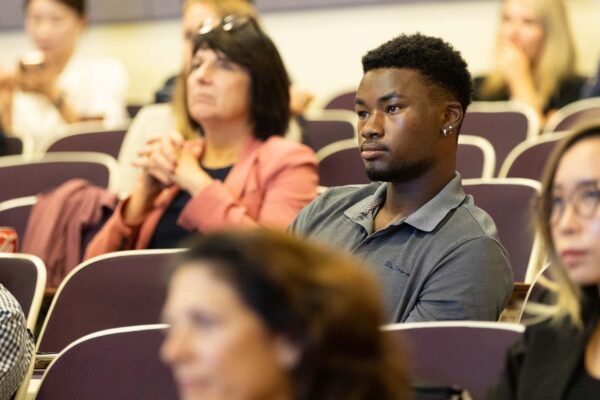Aging is the future.
That statement might sound so obvious it barely deserves uttering. But USC Marshall and the Leonard Davis School of Gerontology believe it’s much more than that. For them, the aging population is one of the central issues of our lifetimes and a focal point for innovation.
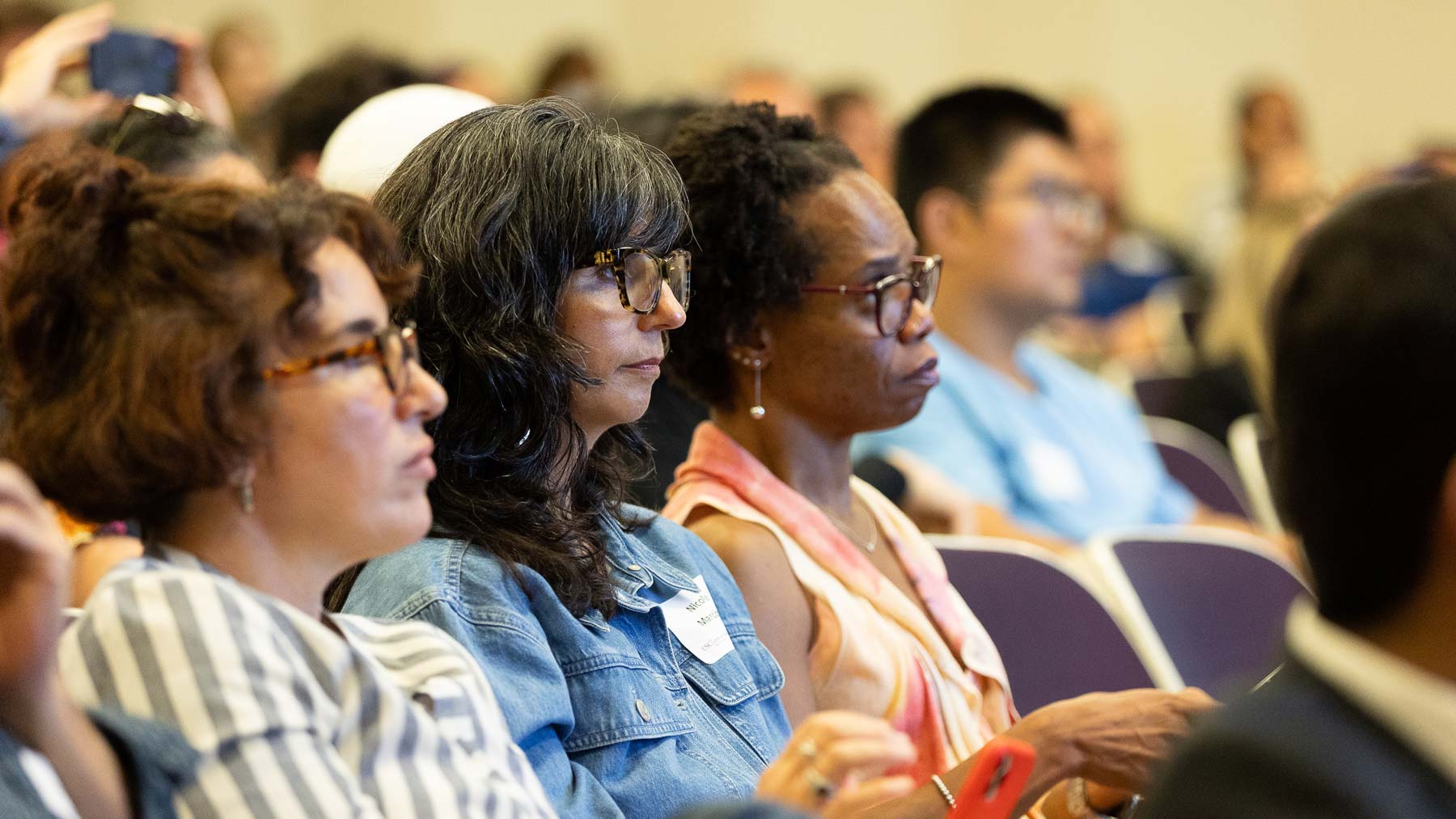
Audience members at the USC Aging is Now | Aging is the Future Entrepreneurship Symposium.
The world population is getting old. Every single day, 10,000 more Americans turn sixty-five. According to a recent New York Times article, by 2034, there will be more people in our country over 65 years old than there are American children. AARP estimates the 50-plus population contributes more than $8 trillion to the U.S. economy, rising to nearly $27 trillion by 2050.
To capitalize on the longevity economy, and USC’s leading role in addressing it, faculty, students, staff, and experts in gerontology, technology, and entrepreneurship gathered on September 8 for the inaugural Aging is Now | Aging is the Future: Entrepreneurship Symposium, jointly hosted by Marshall and Leonard Davis. More than 20 panelists, including Marshall Dean Geoff Garrett and Leonard Davis School Dean Pinchas Cohen, spoke about what entrepreneurs can do to embrace this growing market.
“The zeitgeist behind this event is just spot-on,” said Dean Garrett in his opening remarks. “It’s not a bummer story. It’s a positive story. What we should be thinking about is taking advantage of the opportunities that an aging society produces.”
Dean Cohen, who hosted two panels with leading venture capitalists, noted that the overcapacity crowd illustrated what an important topic this is and called for a collaborative Manhattan Project-like approach to aging.
“We are here at the right time and right place to make a difference in the lives of older people in this country,” Cohen said. “We need the government and private industry to come together and make big investments around aging. And all of you are going to be part of the solution.”
In the past, many products geared toward older adults didn’t provide the same appeal as those marketed toward the younger population. That’s according to one of the symposium’s architects, Abby Fifer Mandell, a senior lecturer at the Lloyd Greif Center for Entrepreneurial Studies. She noticed an underlying bias in 65+ product development. Items weren’t produced with seniors in mind. Or, if they were, they were marketed negatively.
“So often in product innovation for older adults, we focus on the perceived problem, as opposed to the user – who is not a problem,” said Mandell. “This is often the case when it comes to older adult consumers and the people who love older adults. We need innovation for an older population in all areas in all industries.”
Mandell and her students within Marshall have searched for these areas of innovation using the advice of – who else – adults over sixty-five. Called “user-centered design,” this method focuses on the needs and advice of a company’s target consumer base.
Undergraduates in her Student Innovation Design Lab have conducted research into more than 4,000 older adults and discovered there’s progress to be made in every industry, from consumer goods to real estate, technology and AI to education, and so much more.
“We need more options, and more price points with more variety, more nuance, and more choices with better technology. The market and the customer base is entirely wide open,” said Mandell.
Maria Henke, senior associate dean of the Davis School of Gerontology and Mandell’s collaborator in organizing the symposium, agrees.
“Aging is truly everyone’s business, and everyone has a role to play in planning for the future in order to address the needs of an increasingly older population,” said Henke.
She says that misunderstanding older adults means missed opportunities.
“There is a misconception that older adults don’t use technology,” said Henke, who recently launched a master’s degree in applied technology aging at the Davis School. “What’s more, innovative products and programs that work well for older adults, work well for everyone else too.”
Arnold Whitman, a pioneer venture investor in senior care and tech, founder of Formation Capital and Generator Ventures, and a member of the Davis School Board of Councilors said cross-disciplinary collaboration is key.
“Universities should be incubators and educators of future thought leaders, innovators, and research for global aging issues and solutions,” he said. “The opportunity is enormous, and the leadership is much appreciated.”
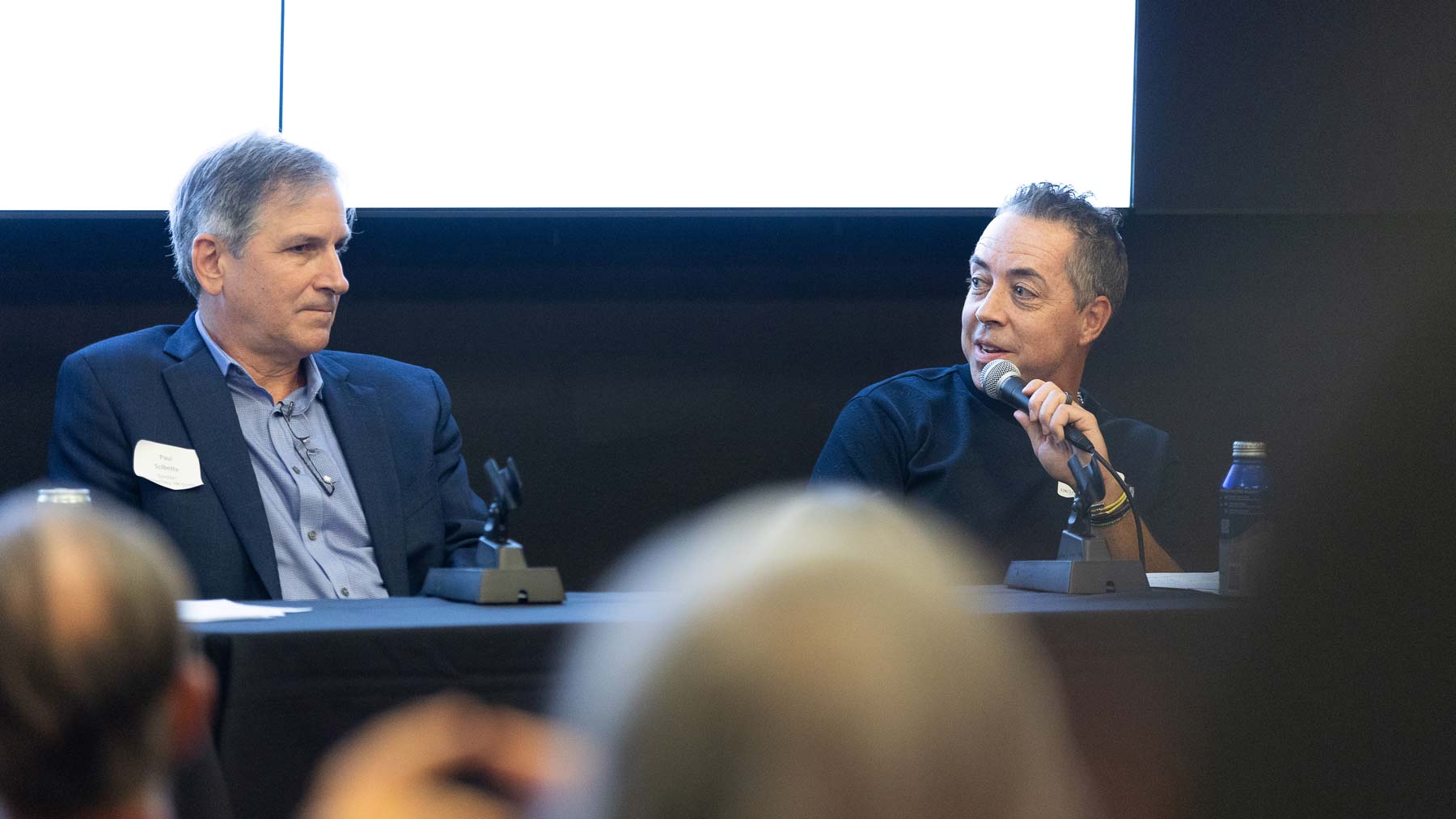
From left to right: Paul Scibetta, Co-Founder and Managing Partner at 22Health Ventures and David Krane, CEO & Managing Partner at GV
David Krane, CEO and managing partner of Google Ventures spoke about how advances in AI are driving investment and optimism and allowing for a level of consumerization that wasn’t available before.
“Things are getting hot”, he said. “More and more people are waking up and seeing change is possible.”
Experts predicted much of that change would be in operational innovation and analytics, enabling technology and services that would help people age in their homes and communities. They encouraged attendees to challenge ageist stereotypes, combat inequity, and persist through obstacles.
The symposium allowed members of Marshall and Leonard Davis to connect through the Ideas Marketplace, where alumni from Marshall and across USC showcased their start-ups, all of which addressed deficiencies in the older adult marketplace.
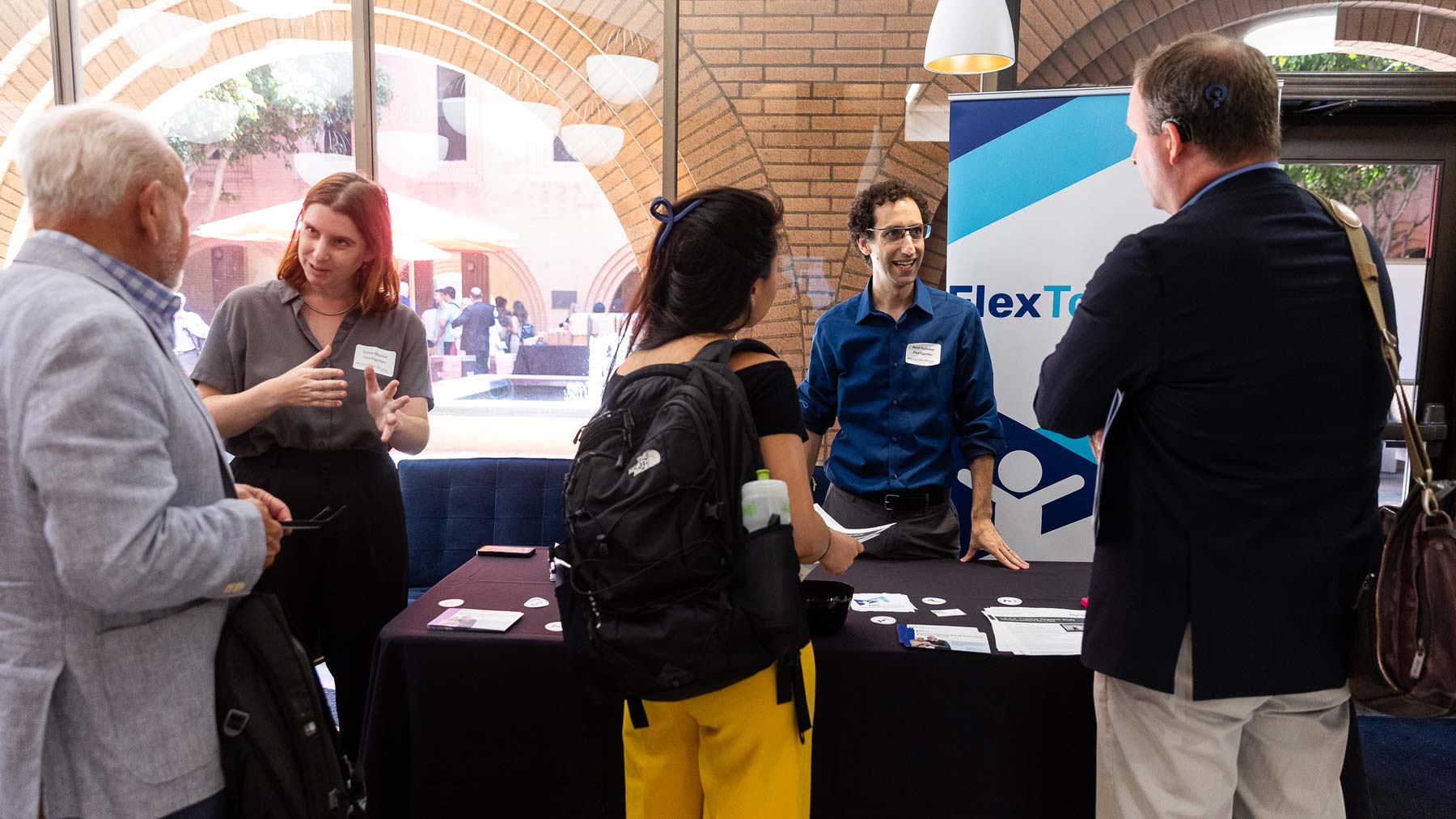
Leonard Davis School Dean Pinchas Cohen, Marshall Dean Geoff Garrett, Abby Fifer Mandell (senior lecturer at the Lloyd Greif Center for Entrepreneurial Studies) and Maria Henke (senior associate dean of the Davis School of Gerontology) inaugurate the Aging is Now/Aging is the Future: Entrepreneurship Symposium.
One exhibitor was FlexTogether, a respiratory rehab for patients with chronic lung disease and respiratory illnesses. Founded by Marshall alumni Emily Mischel and Benjamin Rostoker, the company strives to infuse a bit of fun and support for their older patients. Mischel believes that FlexTogether follows the principles of user-centered design emphasized throughout the symposium.
“The reason we got to where we are is because we engaged with the population we’re trying to serve. And we’re not pretending what it’s like to be a sixty-five-year-old person who lives in Florida with COPD. That’s not my lived experience. So, if we want to understand the lived experience, we [have] to get them in the room.”
Mischel, Rostoker, and others like them may have the chance to make more connections in the future too. Henke sees a future for events like these at USC.
“We hope to become an incubator for innovation and aging for the campus community and beyond,” she said. “We are already planning future conferences and educational activities.”
The efforts won’t stop there. Mandell is also optimistic the interscholastic collaboration could sprout into a full initiative, maybe even new curricula and a minor. (Though, she admits the ladder may take some time and effort to install).
Until then, USC students and faculty will continue to work on the cutting edge. Aging may be the future. But the future is now.


